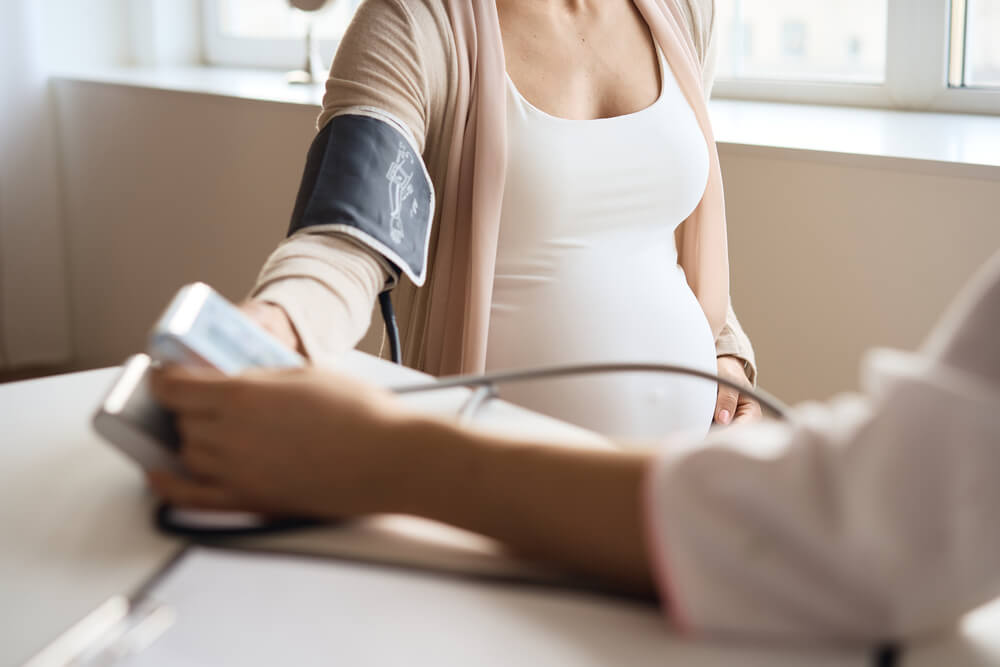Are you experiencing high blood pressure during pregnancy?
You may be diagnosed with preeclampsia, a life-threatening blood pressure condition that is often diagnosed after the 20th week of pregnancy or after giving birth.
According to the March of Dimes, “Preeclampsia affects 2-8% percent of pregnancies worldwide and is the cause of 15% of premature births in the United States.” Most women who are diagnosed with preeclampsia give birth to healthy babies as long as they seek treatment.
That is why regular prenatal and postpartum appointments with your OB-GYN are critical for both your health and the health of the baby.
What is Preeclampsia?
Preeclampsia is a pregnancy-specific condition that’s characterized by high blood pressure and a higher concentration of protein in urine during pregnancy which can negatively impact the heart and other organs of the mother. What’s more, preeclampsia can cause poor placenta blood supply. In more severe cases, it can lead to fluid buildup in the lungs or even hinder the functionality of the liver and kidneys. Namely, when the protein levels in urine are higher than average, this suggests a kidney dysfunction.
Women who are pregnant for the first time tend to develop preeclampsia more often. In some cases, it’s not easy to pinpoint the exact cause. But here are the most common risk factors for preeclampsia:
- Obesity and/or diabetes
- A history of preeclampsia in the family
- Being pregnant with multiples
- Past and/or current issues with high blood pressure or kidney disease
- Autoimmune diseases such as lupus
What are the Common Symptoms of Preeclampsia?

It’s possible for women with preeclampsia to show no apparent symptoms whatsoever. On the other hand, those that do show signs most commonly start with high blood pressure and high levels of protein in urine during pregnancy, leading to water retention, swelling, and weight gain.
Other potential preeclampsia signs include:
- Pain in the right side of the abdomen
- Sensitivity to light or blurry vision, sometimes with dark spots
- Shortness of breath
- Swelling of the face or hands
- Headaches
The more severe symptoms of preeclampsia include:
- Extremely high blood pressure, around or higher than 160/110 mmHg
- Fluid buildup in the lungs
- Reduced production of urine
- Impaired function of liver or kidneys
- Lower levels of blood platelets
It’s crucial to report the above-mentioned and any other unusual symptoms you may have during pregnancy and after the delivery to your OB-GYN. It’s possible to develop preeclampsia postpartum, and signs of postpartum preeclampsia are pretty much the same as the ones during pregnancy.
If a woman experiences any of the severe preeclampsia symptoms, she may have to be admitted to the hospital or even prepared for an emergency delivery. It is not uncommon for the doctor to prescribe medications to manage the patient’s blood pressure or promote the development of the baby’s lungs as well.
Can Preeclampsia Be Cured or Prevented?
Generally speaking, there is no actual cure for preeclampsia. If preeclampsia develops during pregnancy, the symptoms should disappear after giving birth. However, it’s also possible to develop preeclampsia post-delivery, which is why it is so important to be adequately monitored by the doctor even after giving birth to your child.
Women who have a family history of preeclampsia can minimize their risks of developing it during or after pregnancy by:
- Maintaining a healthy body weight even before conception
- Checking your blood sugar levels and blood pressure regularly
- Keeping up with a regular workout routine
- Creating a regular sleeping pattern to get enough rest at night
- Limiting caffeine intake when possible
- Eating healthy foods and avoiding foods with a high-salt content
If you are pregnant and you’re at risk of developing preeclampsia, your doctor may recommend taking a daily dose of baby aspirin, sometimes as early as week 12 of pregnancy. In general, this particular treatment has been found to lower the risk of preeclampsia by about 15%.
Symptoms of preeclampsia should go away after giving birth, anywhere between a couple of days and a couple of weeks. However, some women could still experience high blood pressure due to preeclampsia post-delivery as well. This will require treatment with medications. What’s more, it’s important to mention that developing preeclampsia early in the pregnancy could suggest issues with heart disease and high blood pressure later in life. Therefore, it’s crucial to take the necessary health measures to minimize these risks as well.
What are the Signs of Postpartum Preeclampsia?
The first signs of postpartum preeclampsia could show up within days of giving birth or after a couple of weeks. Look for similar symptoms to the preeclampsia symptoms during pregnancy, such as headaches, nausea, abdominal pain focused on the right side, seeing dark spots, and swelling. Preeclampsia, even if it starts after giving birth, can still be very dangerous if ignored and lead to organ damage, seizures, and stroke.
When Should You Call the Doctor?
Preeclampsia is a life-threatening issue that could even be fatal. It’s paramount to keep all doctor’s appointments and never skip the scheduled urine and blood tests. If you experience any symptoms of preeclampsia, contact your doctor.
It’s sometimes challenging to differentiate when to contact the doctor and when to go right to the nearest hospital emergency room.
The following symptoms are indications for an ER visit:
- Sharp pains in the right side of your abdomen
- Blurry vision with dark spots that don’t seem to disappear
- Severe headaches that don’t seem to diminish
- Convulsing or twitching like having a seizure
- Shortness of breath
The biggest issue with preeclampsia is it can develop without any apparent symptoms This is why it’s so important to keep all your prenatal appointments and remain very transparent and honest with all the symptoms you might notice while pregnant – and even after giving birth.
Knowledge is power. Knowing the risk factors and symptoms and seeking treatment are the key to maternal health and the health of the baby.
Have a family history of preeclampsia? Planning to have a baby soon? Schedule a visit to either our Doral or South Miami office.




